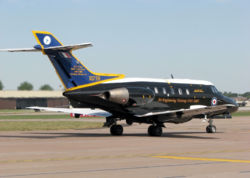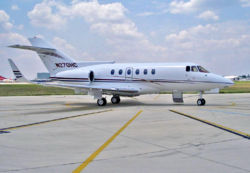PlaneSpottingWorld welcomes all new members! Please gives your ideas at the Terminal.
British Aerospace BAe 125
| British Aerospace BAe 125 | |
|---|---|
| A Raytheon Hawker 800 on the tarmac. | |
| Type | Mid-size business jet |
| Manufacturer | Raytheon (since 1993) British Aerospace (1977-1993) Hawker Siddeley (to 1977) |
| Designed by | de Havilland |
| Maiden flight | 1962-08-13 |
| Number built | >1,000 |
| Variants | Raytheon Hawker 800 |
The twin-engined British Aerospace BAe 125 is the world's best selling mid-size corporate jet, now marketed as the Raytheon Hawker 800. It was known as the Hawker Siddeley HS125 until 1977. It is also used by the British Royal Air Force as a navigation trainer (as the Hawker Siddeley Dominie), and was used by the United States Air Force as a calibration aircraft (as the C-29).
Contents
Development
In 1961, de Havilland began working on a revolutionary small business jet known as DH.125 Jet Dragon. The first of two prototypes flew on 13 August 1962 powered by the Bristol Siddeley Viper turbojet
The aircraft went through many designation changes during its service life. Originally DH.125, it was renamed to HS.125 when de Havilland became a part of the Hawker Siddeley group in 1959. When Hawker Siddeley Aircraft merged with BAC to form British Aerospace in 1977, the name changed to BAe 125. Then, when British Aerospace sold its Business Jets Division to Raytheon in 1993, the jet acquired its current monicker Raytheon Hawker. In 1996, production was transferred from British Aerospace's Broughton Plant outside Chester to the United States.
Over 1,000 aircraft have been built.
Variants
- DH.125 Series 1 - first production version, 8 built
- DH.125 Series 1A/1B - upgraded Bristol Siddeley Viper 521 (Series 1A) or 522 (Series 1B) engines with 3,090 lbf (13.8 kN) of thrust each
- HS.125 Series 2 - military versions
- Dominie T.Mk.1, T.Mk.2 - navigation trainer for Royal Air Force
- CC.Mk.1, Mk.2, and Mk.3 - liaison aircraft for Royal Air Force
- HS.125 Series 3 - upgraded engines
- HS.125 Series 400 - upgraded engines
- HS.125 Series 600 - 3 ft 1 in (0.94 m) fuselage stretch to increase capacity to 14 passengers
- HS.125 Series 700 - Honeywell TFE731-3RH turbofan engines with 3,720 lbf (16.6 kN) of thrust each, first flight 19 June 1976
- HS.125 Protector - Series 700-based maritime patrol aircraft with a search radar and cameras
- BAe.125 Series 800 - increased wingspan, streamlined nose, tail fin extension, increased fuel capacity, first corporate jet to feature an EFIS cockpit, upgraded engines, first flight 26 May 1983
- Hawker 800 - BAe.125-800 after 1993
- Hawker 800XP - TFE731-5BR1H turbofan engines with 4,660 lbf (20.8 kN) of thrust each
- Hawker 800SP and 800XP2 - New designation for 800A/B and 800XP aircraft when upgraded with aftermarket winglets
- C-29A - Series 800 for US military designed to replace Lockheed C-140A, used by the Air Force Communications Service to check navigation aids and communications at US airbases around the world, participated in Operation Desert Shield and Operation Desert Storm during the First Persian Gulf War.
- U-125 - Series 800-based search and rescue aircraft for Japan
- BAe.125 Series 1000 - intercontinental version of the Series 800, 2 ft 9 in (0.84 m) fuselage stretch to increase capacity to 15, increased fuel capacity, Pratt & Whitney Canada PW-305 turbofans with 5,200 lbf (23.2 kN) thrust each, first flight 16 June 1990, 52 built
- Hawker 1000 - BAe.125-1000 after 1993

Operators
Private operators worldwide, armed forces of United Kingdom, Ireland, United States, Japan, Argentine, Botswana, Brazil, Malawi, Malaysia, Saudi Arabia,UAE (Hamra Air), South Africa.
Recently, a group of Hawker 125 operators, aircraft parts sales companies and maintenance service providers specializing in Hawker 125 series technical & parts support have joined together to share solutions to ongoing technical issues related to the continued operations of a maturing Hawker fleet.
Specifications (Hawker 850XP)
General characteristics
- Crew: 2
- Capacity: 8
- Length: 51 ft 2 in (15.6 m)
- Wingspan: 54 ft 4 in (16.6 m)
- Height: 18 ft 1 in (5.5 m)
- Wing area: ft² (m²)
- Empty weight: 15,670 lb (7,110 kg)
- Useful load: 11,790 lb (5,350 kg)
- Max takeoff weight: 28,000 lb (12,700 kg)
- Powerplant: 2× Honeywell TFE731-5BR turbofans, 4,660 lbf (20.8 kN) each
Performance
- Maximum speed: 514 mph (446 knots, 830 km/h)
- Cruise speed: 463 mph (402 knots, 745 km/h)
- Range: 2,522 mi (2,191 nm, 4,059 km)
- Service ceiling: 41,000 ft (12,500 m)
- Rate of climb: 1,950 ft/min (9.9 m/s)
References
- Donald, D.; Lake, J. (editors) (1996). Encyclopedia of world military aircraft.. AIRtime Publishing. ISBN 1-880588-24-2.
- Mason, F. K. (1991). Hawker aircraft since 1920. Putnam Aeronautical Books. ISBN 1-55750-351-6.
- Raytheon Aircraft Company
- Hawker 125 Vendor & Operator Committee Website
External links
Related content
Related development
Comparable aircraft
Designation sequence
- DH/HS/BAe:
- US Military:
Related lists
- List of active United Kingdom military aircraft
- List of aircraft of the RAF
- List of business aircraft
- List of military aircraft of the United States
Lists relating to aviation | |
|---|---|
| General | Timeline of aviation · Aircraft · Aircraft manufacturers · Aircraft engines · Aircraft engine manufacturers · Airports · Airlines |
| Military | Air forces · Aircraft weapons · Missiles · Unmanned aerial vehicles (UAVs) · Experimental aircraft |
| Notable incidents and accidents | Military aviation · Airliners · General aviation · Famous aviation-related deaths |
| Records | Flight airspeed record · Flight distance record · Flight altitude record · Flight endurance record · Most produced aircraft |

